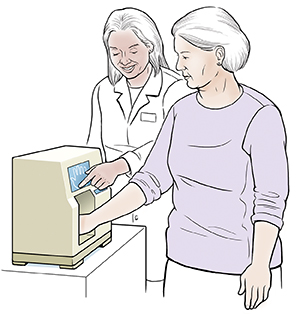Osteoporosis: Screening for Bone Loss
Osteoporosis: Screening for Bone Loss

Bone density testing
Bone density testing is safe, quick, easy, and painless. It can detect osteoporosis before a fracture happens. It can also measure the response to treatment. There are several types of tests that you may have, including:
-
Central tests. These are used for screening and diagnosis. They measure density in the hip and spine. The main central test is the dual energy X-ray absorptiometry (DXA). The DXA is the standard bone density test.
-
Peripheral tests. These are used for screening. They measure density in the finger, wrist, knee, shin, or heel. A common peripheral test is the quantitative ultrasound (QUS). But QUS screening is not as accurate or widely accepted as DXA screening.
Who should be tested?
-
All postmenopausal women under age 65, with one or more risk factors in addition to menopause.
-
All women age 65 and older.
-
Postmenopausal women with fractures.
-
Women who are thinking about treatment for osteoporosis.
-
Women who have been on hormone therapy for a long time.
-
Men or women with certain health conditions or who are taking certain medicines (such as glucocorticoids or prednisone) for a long time.
Common testing sites
Any bone can fracture. But with osteoporosis some bones fracture more easily. These include bones in the spine, wrist, shoulder, and hip. That’s why bone density testing may be done at one or more of these sites.
Understanding your results
Your test results may seem confusing at first. Don’t be afraid to ask your provider to explain. Your healthcare provider will compare your bone mineral density (BMD) with the BMD of young, healthy bone. The result is called a T-score. Bones remodel at different rates. So, a healthy T-score in the wrist doesn’t mean the spine is also healthy. That’s why more than one site may be scanned.
Updated:
January 23, 2020
Sources:
Screening for Osteoporosis in the Adult U.S. Population: ACPM Position Statement on Preventive Practice. Lim, LS. American Journal of Preventive Medicine. 2009;36(4):366-75.
Reviewed By:
Banerjee, Rahul, MD,Fetterman, Anne, RN, BSN